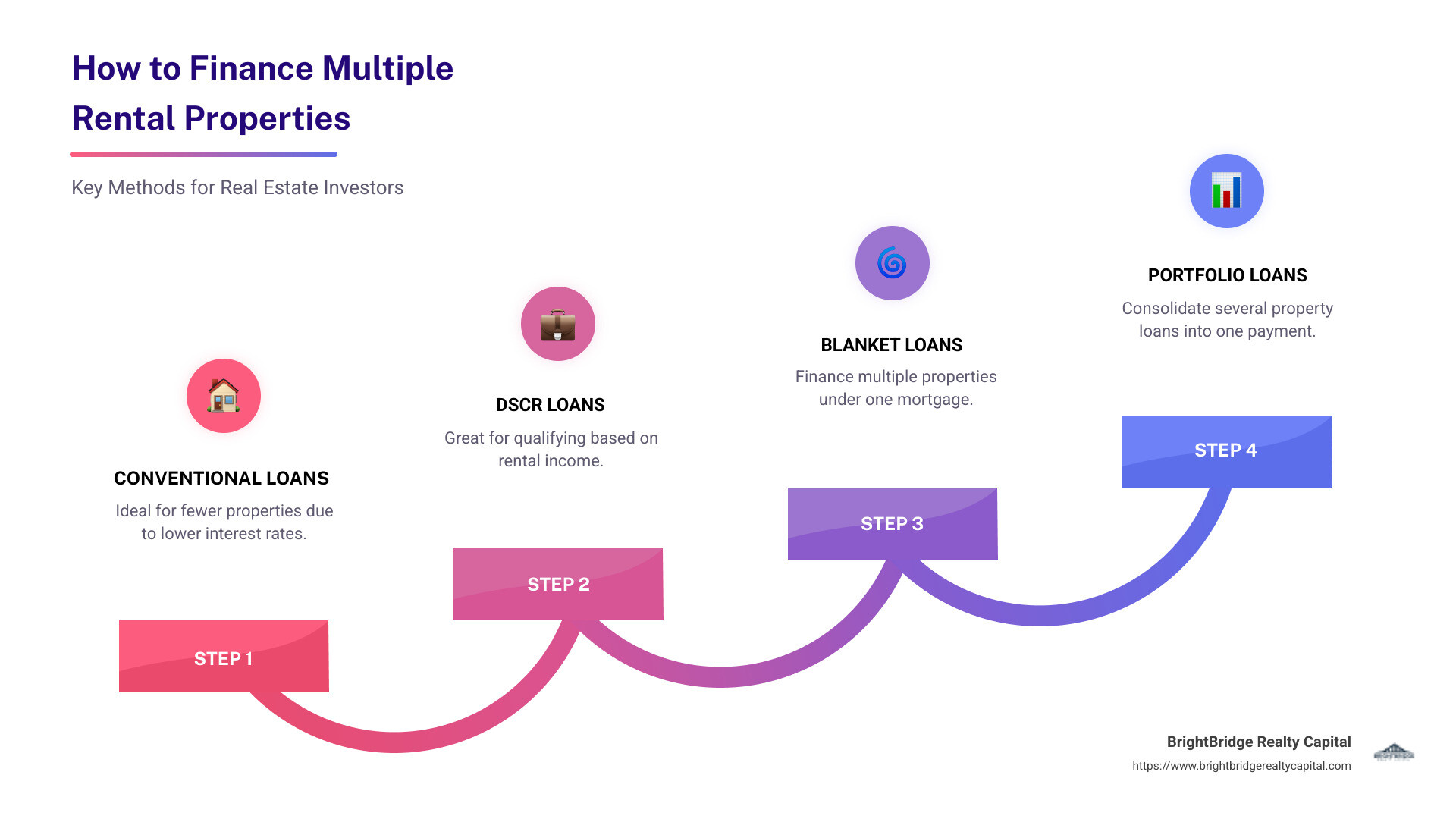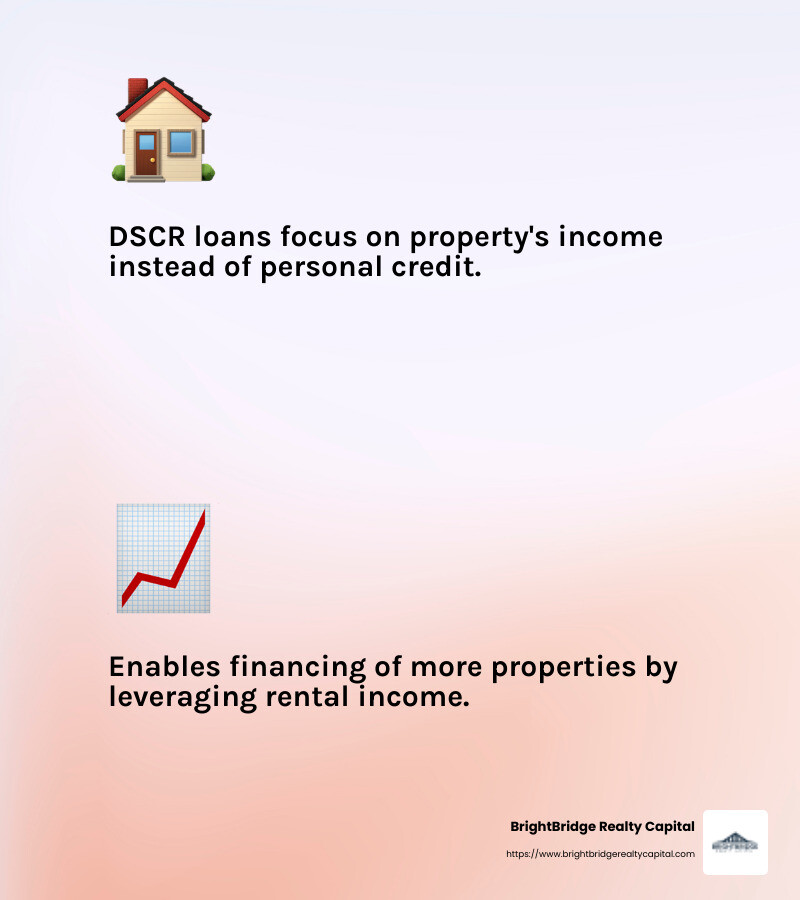Scaling Up: Strategies for Financing Multiple Rentals

How to finance multiple rental properties is a key concern for real estate investors looking to grow their portfolios efficiently. To quickly address this, here are some common methods:
- Conventional Loans: Ideal for those starting with fewer properties due to lower interest rates.
- Debt Service Coverage Ratio (DSCR) Loans: Custom for investors relying on rental income to qualify.
- Blanket Loans: Useful for financing multiple properties under a single mortgage.
- Portfolio Loans: Designed to consolidate several property loans into one manageable payment.
Investing in multiple rental properties can be a lucrative strategy for building long-term wealth. Owning several properties not only offers an array of income streams but also aids in diversifying risk across different markets.
When one property faces vacancy or unexpected expenses, income from other rentals helps stabilize and offset potential losses. Furthermore, spreading investments geographically minimizes exposure to local market fluctuations, providing a safer investment landscape.
By tapping into these diverse revenue streams, investors stand to increase their net income while enjoying strategic growth. This balanced approach creates a robust real estate portfolio prepared to withstand market shifts and capitalize on new opportunities.

Quick how to finance multiple rental properties terms:
- rental property financing
- how to finance your first rental property
- creative financing for rental property
How to Finance Multiple Rental Properties
Building a rental property empire begins with understanding how to finance multiple rental properties effectively. Let's explore some of the most common financing options available:
Conventional Loans
Conventional loans are a popular choice for investors starting with fewer properties. These loans typically offer lower interest rates, making them an attractive option for those with strong credit scores and a low debt-to-income ratio. Conventional loans are often limited to financing up to four properties, but they provide a solid foundation for new investors.
Unlike other loan types, conventional loans require thorough documentation, including tax returns, credit scores, and proof of income. While these loans are reliable, they can become cumbersome as your portfolio grows due to the limit on the number of properties they can cover.
DSCR Loans
For investors relying on rental income to qualify for financing, Debt Service Coverage Ratio (DSCR) loans are a custom solution. These loans assess the income-generating potential of your properties rather than your personal financial history. This means the focus is on whether the property's income can cover the debt payments.

DSCR loans allow you to finance more than ten properties under a single loan, making them ideal for those aiming to expand their portfolio swiftly. This approach simplifies mortgage payments and can reduce interest obligations, especially for seasoned investors.
Blanket Loans
Blanket loans are a strategic option for those looking to finance multiple properties under a single mortgage. This type of loan is beneficial if you plan to sell some properties in the future, as it allows you to release one or several investments without the entire mortgage coming due.
Though less common, blanket loans help avoid multiple loan origination fees and maintain one interest rate across all properties. However, they often come with stricter requirements, such as a higher minimum credit score and increased closing costs.
Portfolio Loans
Portfolio loans are designed to consolidate several property loans into one manageable payment. Offered by private lenders, these loans are customizable, allowing terms like down payment, interest rate, and amortization to be custom to the borrower's needs.

Portfolio loans are particularly advantageous for investors with ten or more properties, offering flexibility and ease in managing a large real estate portfolio. While fees and interest rates might be higher than conventional loans, the convenience and scalability they provide are best for serious investors.
By understanding these financing options, investors can strategically choose the best loan type to suit their needs and objectives. As you scale your real estate portfolio, consider these approaches to optimize your investments and steer the complexities of property financing efficiently.
Financing Options for Different Portfolio Sizes
When scaling your real estate portfolio, choosing the right financing option is crucial. Here's a breakdown based on the size of your portfolio:
4 Properties or Less
For those starting out with up to four properties, conventional financing is your go-to option. These loans offer low interest rates, especially for borrowers with solid credit scores and a low debt-to-income ratio. Conventional loans are typically offered by traditional banks and credit unions.
- Loan terms: Usually 30 years, which helps keep monthly payments manageable.
- Down payment: Expect to put down at least 20% of the property's value.
- Documentation: Be prepared to provide tax returns, credit scores, and proof of income.
While conventional loans are a great starting point, they can become limiting as you approach the four-property threshold.
5 to 10 Properties
As your portfolio grows beyond four properties, consider the Freddie Mac Investment Property Mortgages program. This program allows financing for up to 10 properties with specific requirements:
- Credit score: A minimum of 720 if you have seven or more financed properties.
- Debt-to-income ratio: Must not exceed 45%.
- Down payments: Range from 15% to 25%, depending on the number of properties.
- Cash reserves: Six months' worth for each property is required.
The Freddie Mac program is ideal for investors looking to expand their portfolio while maintaining competitive interest rates and structured financing.
10 Properties or More
For those with ambitions beyond 10 properties, blanket loans and portfolio mortgages become viable options:
- Blanket loans: These allow you to finance multiple properties under a single mortgage. They simplify management by consolidating payments and offer flexibility if you plan to sell individual properties later.
- Portfolio mortgages: Custom by private lenders, these loans are held within the lender's portfolio, allowing for customized terms. They are suitable for investors with extensive property holdings.
While these options often come with higher interest rates and fees compared to conventional loans, the flexibility and scalability they offer are invaluable for managing a large real estate empire.
By selecting the right financing strategy for your portfolio size, you can optimize your investments and continue to grow your rental property business effectively. Next, we'll explore some creative financing strategies to further improve your investment approach.
Creative Financing Strategies
When it comes to how to finance multiple rental properties, thinking outside the box can open up new opportunities. Here are some creative strategies to consider:
Cash-Out Refinancing
Cash-out refinancing allows you to take advantage of the equity you've built in your existing properties. By refinancing your mortgage for more than you owe, you can access the extra cash. This can be used to purchase additional rental properties or improve your current ones. It's a popular option because it often offers lower interest rates compared to other types of loans.
- How it works: Refinance your property, take out more than you owe, and pocket the difference.
- Benefits: Access to cash with potentially lower interest rates.
- Considerations: Your monthly mortgage payments may increase.
Home Equity Line of Credit (HELOC)
A Home Equity Line of Credit (HELOC) works like a credit card. You borrow against the equity in your home, using it as a revolving line of credit. This can be a flexible way to fund new investments or renovations.
- How it works: Borrow and repay as needed, similar to a credit card.
- Benefits: Flexibility and only pay interest on what you use.
- Considerations: Variable interest rates can lead to fluctuating payments.
Self-Directed IRA
A self-directed IRA lets you use retirement funds to invest in real estate. Unlike traditional IRAs, it allows for a wider range of investment options, including rental properties.
- How it works: Use your IRA to buy property directly, keeping profits tax-deferred.
- Benefits: Diversify your retirement portfolio with real estate.
- Considerations: Complex rules and potential penalties for improper use.
401(k) for Small Business Owners
If you're a small business owner, you might have access to a 401(k) that allows for real estate investment. You can either take a loan against your 401(k) or roll it into a self-directed account.
- How it works: Borrow from your 401(k) or use it to invest directly in property.
- Benefits: Access to large sums of money with potential tax advantages.
- Considerations: Risk of penalties and taxes if not managed correctly.
These creative financing strategies provide alternative avenues for funding your real estate ventures. By leveraging the assets you already have, you can expand your portfolio without relying solely on traditional loans. Next, we'll dig into how to analyze investment properties to ensure you're making smart financial decisions.
Analyzing Investment Properties
Before diving into how to finance multiple rental properties, it's crucial to understand how to analyze them effectively. This ensures you make smart investment choices. Let's explore some key metrics.
Gross Rent Multiplier (GRM)
The Gross Rent Multiplier (GRM) is a simple way to estimate the potential profitability of a rental property. It's calculated by dividing the property price by the gross rental income.
For example, if a property costs $100,000 and generates $12,000 in annual rent, the GRM is 8.3. A lower GRM often suggests a better investment, as it indicates more rental income relative to the purchase price.
Cash Flow
Cash flow is the pre-tax money left after collecting rent and paying all expenses. If a property earns $12,000 annually and expenses are $9,500, the cash flow is $2,500. Positive cash flow means you're earning more than you're spending, which is ideal for any investment.
Net Operating Income (NOI)
Net Operating Income (NOI) is your income after subtracting operating expenses but before mortgage payments. If your cash flow is $2,500 and your mortgage is $3,500, the NOI is $6,000. A high NOI indicates a strong investment, as it shows the property is generating income after covering basic expenses.
Cap Rate
The Cap Rate measures the expected return on investment by comparing NOI to property value. For instance, if a property is worth $100,000 and the NOI is $6,000, the cap rate is 6%. A higher cap rate often means a higher return, but it can also imply higher risk.
Cash on Cash Return
Cash on Cash Return compares annual pre-tax cash flow to the total cash invested. If you invest $25,000 and earn $2,500 annually, the return is 10%. This metric is vital for understanding the efficiency of your investment in generating returns.
By mastering these metrics, you'll be better equipped to assess potential investments and make informed decisions. Up next, we'll answer some frequently asked questions about financing multiple rentals.
Frequently Asked Questions about Financing Multiple Rentals
How can I finance multiple rental properties with no money?
Finding ways to finance multiple rental properties with no money upfront might seem daunting, but creative financing strategies can help.
Leverage Equity: Use the equity in your existing properties to fund new purchases. Options like cash-out refinancing or a Home Equity Line of Credit (HELOC) allow you to tap into your property's value without selling it.
Seller Financing: In this setup, the seller acts as the lender. You make direct payments to them, which can be beneficial if traditional loans are hard to secure.
Crowdfunding and Syndicates: Pool resources with other investors. This approach reduces your initial capital requirement and allows you to participate in larger investments.
What are the tax benefits of owning multiple rental properties?
Owning rental properties comes with several tax perks that can improve your investment returns.
Depreciation: The IRS allows you to depreciate rental property over 27.5 years. This non-cash deduction reduces your taxable income. For example, a $150,000 property (excluding land) can provide a yearly depreciation deduction of about $5,455.
Operating Expenses: Deduct expenses like property management fees, repairs, and maintenance from your taxable income. This can significantly reduce your tax bill.
These tax benefits can make a substantial difference in your overall profitability.
How do I manage multiple rental properties effectively?
Managing several properties can be overwhelming, but strategic approaches can simplify the process.
Property Management: Hiring a property management company can save time and reduce stress. They handle tenant issues, collect rent, and oversee maintenance.
Hiring Professionals: Consider accountants for financial management and legal professionals for compliance issues. This ensures everything runs smoothly and legally.
Organization: Keep detailed records of each property's income, expenses, and maintenance schedules. Use property management software to streamline this process.
By leveraging these strategies, you can efficiently manage multiple properties and focus on growing your portfolio.
Conclusion
When it comes to scaling up your real estate investments, BrightBridge Realty Capital is your ideal partner. We understand that each investor has unique needs, and that's why we offer customized solutions to help you finance multiple rental properties.
One of our standout features is our ability to offer fast closings—often within just a week. This speed can be a game-changer in the competitive real estate market, allowing you to seize opportunities as they arise without delay.
Our direct lending approach eliminates intermediaries, providing you with competitive rates and a seamless process. Whether you're considering conventional loans, blanket loans, or exploring creative financing strategies, we have the expertise to guide you through each option.
Our nationwide reach ensures that no matter where your investment properties are located, we can provide the capital you need. We are committed to helping you grow your portfolio efficiently and effectively.
Ready to take the next step in your real estate journey? Explore our loan options and find how BrightBridge Realty Capital can help you achieve your investment goals. With us, your path to expanding your rental property business is clearer and faster than ever.


